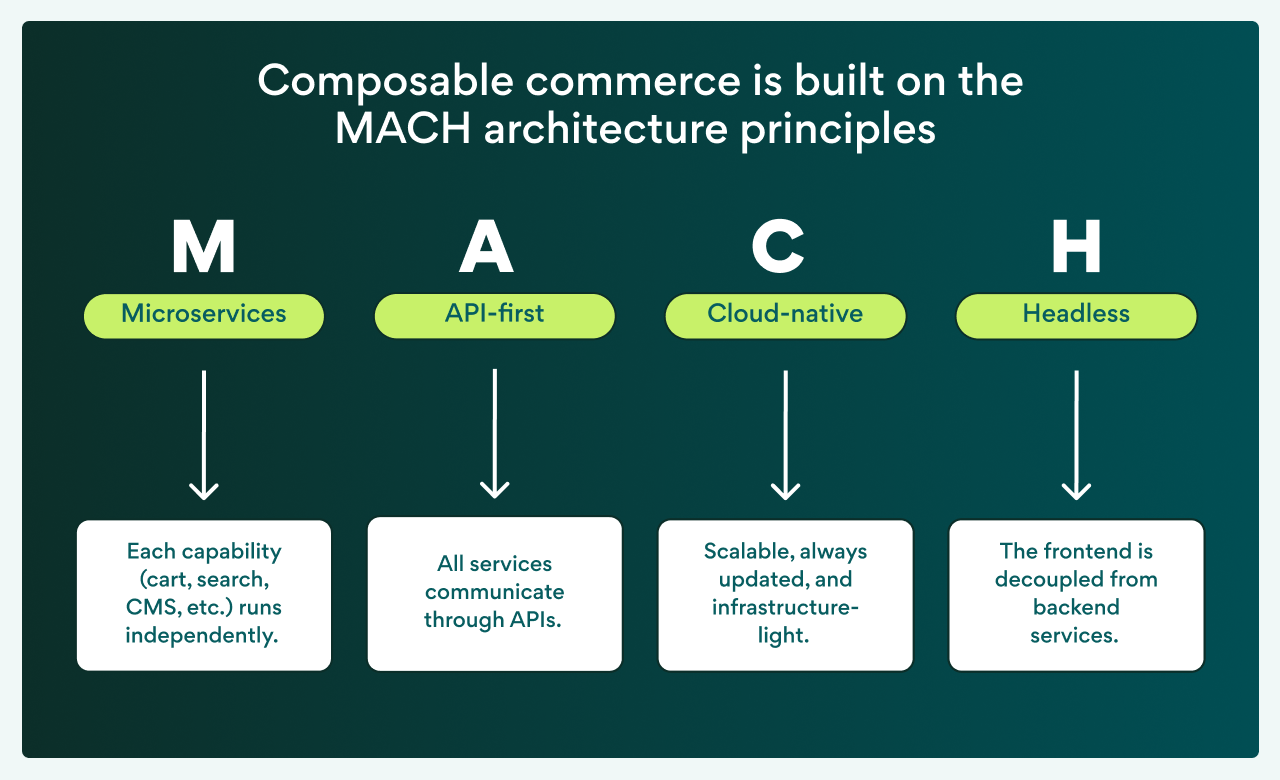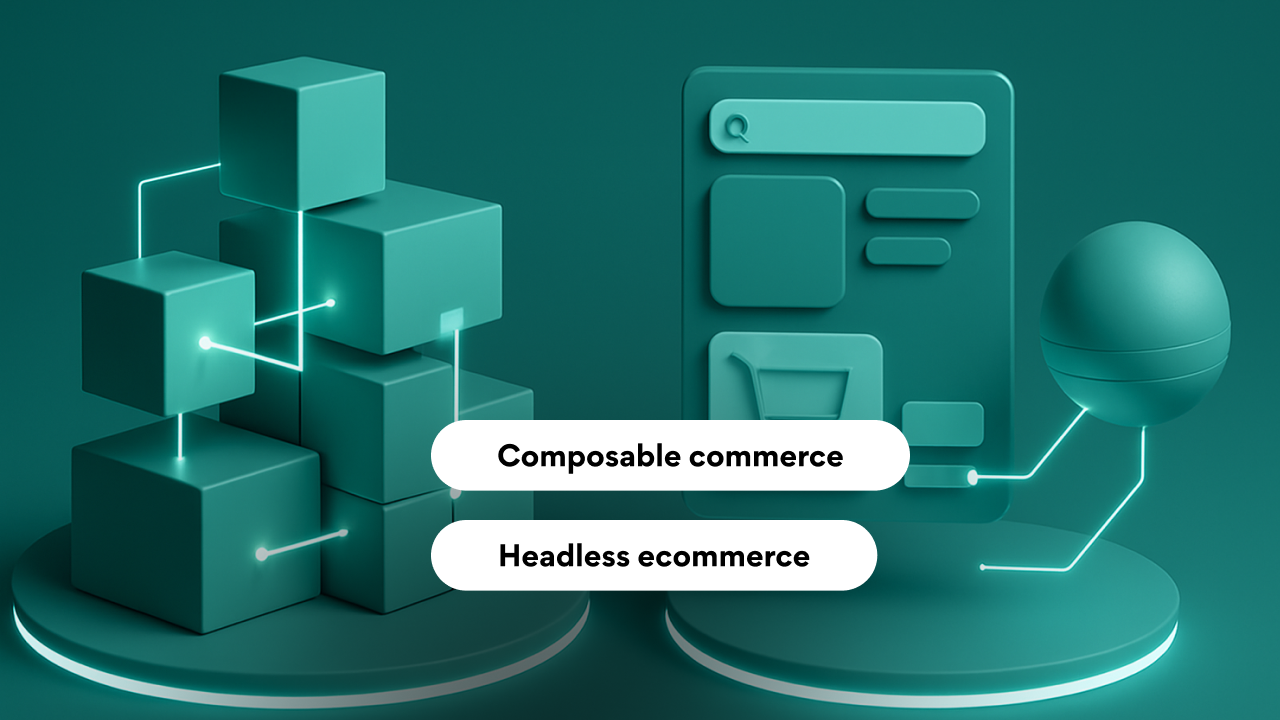



Headless eCommerce is an eCommerce architecture that separates the frontend (“head”) of a website from its backend (“body”), allowing brands to deliver more flexible, personalized, and faster shopping experiences across multiple channels.
In a traditional (monolithic) eCommerce setup, the frontend (what users see — templates, themes, design) and backend (where data, checkout, and inventory live) are tightly connected.
In headless eCommerce, those two layers are decoupled and communicate via APIs. The frontend is built using modern frameworks like React, Next.js, or Vue. The backend (like Shopify, Magento, or BigCommerce) handles data, checkout, and business logic. APIs connect the two, sending product data, customer info, and orders back and forth seamlessly.
Imagine your Shopify store’s backend powers your products, orders, and payments —
but instead of using Shopify’s built-in theme, you build your own custom storefront with Next.js for blazing-fast performance and total design freedom.
The main advantages of adopting a headless eCommerce model come down to flexibility and control. With a decoupled architecture, brands have complete freedom over design and user experience.
Because the frontend and backend operate independently, sites built on headless architectures often achieve faster load times and stronger SEO performance, while maintaining the ability to scale and evolve without disrupting the core business logic or backend systems.
That flexibility, however, comes with challenges. A headless build typically requires more developer expertise and ongoing maintenance, since multiple systems need to work together smoothly. Integrations can become complex, especially as more tools are added, and initial setup costs may be higher compared to traditional all-in-one platforms.
In the world of digital commerce, composable commerce and headless eCommerce are often mentioned in the same breath. They share similar goals (agility, scalability, and a modern tech foundation), but each represents a distinct approach to building an online business.
In this guide, we break down the key differences and help you decide how to future-proof your eCommerce business.
Composable commerce goes even further in terms of specialization. In composable commerce, every part of an online store (from product listings to checkout and content management) is powered by specialized, interchangeable services that communicate through APIs to form a single, flexible ecosystem.
Instead of relying on a single, all-in-one eCommerce platform (a “monolith”), composable commerce lets you assemble your ideal tech stack from specialized tools that fit your exact business needs.
Composable commerce is grounded in the MACH architecture — a set of principles designed to make digital systems more flexible and future-proof. The acronym stands for Microservices, API-first, Cloud-native, and Headless.
In this model, every capability (such as cart, search, or CMS) functions as an independent microservice, allowing teams to update or replace features without affecting the rest of the system. Being API-first means that each service communicates seamlessly with others through standardized interfaces, ensuring smooth integrations and data flow.
Cloud-native infrastructure makes the entire setup scalable, automatically updated, and lightweight to maintain. Finally, the headless component separates the frontend from backend services, giving businesses full creative control over the user experience while keeping the underlying technology flexible and adaptable.

Example stack:
Each piece can be added, swapped, or removed without replatforming your entire system.
Composable commerce gives brands ultimate flexibility to innovate faster, scale globally, and personalize customer experiences without being locked into one vendor’s ecosystem. It’s essentially Lego-style eCommerce — build, adapt, and evolve as you grow.
Composable commerce gives brands a level of freedom and control that traditional or even headless platforms can’t match. Because each function is powered by its own specialized service, businesses can choose best-of-breed tools for everything from search and payments to CMS and checkout. This modular approach allows companies to scale individual components as traffic and demand grow, rather than overhauling the entire system.
The model also accelerates innovation. Teams can launch new features and updates faster, since each service operates independently. And because the entire architecture is API-based, businesses can swap or upgrade technologies without downtime, keeping their stack modern and adaptable as the market evolves.
Still, this flexibility comes with added complexity. A composable setup requires even stronger technical expertise and integration skills than a headless one, particularly to ensure smooth communication between multiple services. It can also introduce higher upfront costs and greater vendor management challenges, as multiple systems must be maintained and optimized to work together efficiently.

In the world of digital commerce, composable commerce and headless eCommerce are often mentioned in the same breath. They share similar goals (agility, scalability, and a modern tech foundation), but each represents a distinct approach to building an online business.
In this guide, we break down the key differences and help you decide how to future-proof your eCommerce business.
Headless eCommerce is an eCommerce architecture that separates the frontend (“head”) of a website from its backend (“body”), allowing brands to deliver more flexible, personalized, and faster shopping experiences across multiple channels.
In a traditional (monolithic) eCommerce setup, the frontend (what users see — templates, themes, design) and backend (where data, checkout, and inventory live) are tightly connected.
In headless eCommerce, those two layers are decoupled and communicate via APIs. The frontend is built using modern frameworks like React, Next.js, or Vue. The backend (like Shopify, Magento, or BigCommerce) handles data, checkout, and business logic. APIs connect the two, sending product data, customer info, and orders back and forth seamlessly.
Imagine your Shopify store’s backend powers your products, orders, and payments —
but instead of using Shopify’s built-in theme, you build your own custom storefront with Next.js for blazing-fast performance and total design freedom.
The main advantages of adopting a headless eCommerce model come down to flexibility and control. With a decoupled architecture, brands have complete freedom over design and user experience.
Because the frontend and backend operate independently, sites built on headless architectures often achieve faster load times and stronger SEO performance, while maintaining the ability to scale and evolve without disrupting the core business logic or backend systems.
That flexibility, however, comes with challenges. A headless build typically requires more developer expertise and ongoing maintenance, since multiple systems need to work together smoothly. Integrations can become complex, especially as more tools are added, and initial setup costs may be higher compared to traditional all-in-one platforms.
Composable commerce goes even further in terms of specialization. In composable commerce, every part of an online store (from product listings to checkout and content management) is powered by specialized, interchangeable services that communicate through APIs to form a single, flexible ecosystem.
Instead of relying on a single, all-in-one eCommerce platform (a “monolith”), composable commerce lets you assemble your ideal tech stack from specialized tools that fit your exact business needs.
Composable commerce is grounded in the MACH architecture — a set of principles designed to make digital systems more flexible and future-proof. The acronym stands for Microservices, API-first, Cloud-native, and Headless.
In this model, every capability (such as cart, search, or CMS) functions as an independent microservice, allowing teams to update or replace features without affecting the rest of the system. Being API-first means that each service communicates seamlessly with others through standardized interfaces, ensuring smooth integrations and data flow.
Cloud-native infrastructure makes the entire setup scalable, automatically updated, and lightweight to maintain. Finally, the headless component separates the frontend from backend services, giving businesses full creative control over the user experience while keeping the underlying technology flexible and adaptable.

Example stack:
Each piece can be added, swapped, or removed without replatforming your entire system.
Composable commerce gives brands ultimate flexibility to innovate faster, scale globally, and personalize customer experiences without being locked into one vendor’s ecosystem. It’s essentially Lego-style eCommerce — build, adapt, and evolve as you grow.
Composable commerce gives brands a level of freedom and control that traditional or even headless platforms can’t match. Because each function is powered by its own specialized service, businesses can choose best-of-breed tools for everything from search and payments to CMS and checkout. This modular approach allows companies to scale individual components as traffic and demand grow, rather than overhauling the entire system.
The model also accelerates innovation. Teams can launch new features and updates faster, since each service operates independently. And because the entire architecture is API-based, businesses can swap or upgrade technologies without downtime, keeping their stack modern and adaptable as the market evolves.
Still, this flexibility comes with added complexity. A composable setup requires even stronger technical expertise and integration skills than a headless one, particularly to ensure smooth communication between multiple services. It can also introduce higher upfront costs and greater vendor management challenges, as multiple systems must be maintained and optimized to work together efficiently.
While headless eCommerce and composable commerce both move away from rigid, monolithic platforms, they’re not the same thing. Headless focuses on separating the frontend from the backend, while composable takes it a step further — breaking the entire commerce ecosystem into modular, interchangeable parts.
In simple terms:
In other words, headless is often the first step toward composable.
You can think of headless as renovating the front of your store for a better customer experience, while composable is like rebuilding the entire store layout using custom-built sections that fit your exact needs.
Both headless eCommerce and composable commerce offer flexibility and innovation but they suit different stages of business growth and levels of technical maturity. Choosing the right approach depends on your goals, resources, and long-term strategy.
You want more frontend control and performance without completely rebuilding your tech stack. Headless is a great first step for brands moving away from rigid monolithic systems but not ready for full composability. It’s best for:
Example:
A fashion retailer wants a faster, more flexible storefront but prefers to keep using Shopify’s backend. They build a React-based custom frontend while maintaining Shopify’s backend logic — that’s a headless setup.
You need maximum agility, scalability, and customization across your entire eCommerce ecosystem. Composable commerce suits businesses that want full control over every component and the ability to evolve quickly as technology changes. Composable commerce is best for:
Example:
An international retailer combines commercetools (backend), Algolia (search), Contentful (CMS), and Stripe (payments) into a single, API-driven ecosystem — a fully composable commerce setup.
The shift from headless to composable commerce marks the next major leap in how digital businesses build and scale their online experiences. What started as a quest for design freedom (headless) is now transforming into a movement for complete flexibility, agility, and innovation (composable).
Headless commerce separates the frontend from the backend, giving brands the freedom to design custom storefronts and deliver content consistently across multiple channels. But as technology stacks grew more complex, businesses needed more than just frontend freedom — they needed modularity at every layer of their eCommerce ecosystem.
As customer expectations rise, brands need to deliver personalized, omnichannel experiences faster than ever. Composable commerce gives teams the ability to experiment, integrate, and innovate without replatforming.
For many businesses, the path forward is a gradual evolution:
It’s a strategy that keeps risk low but ensures the business can scale sustainably over time.
At ALLSTARSIT, we help eCommerce companies build and scale high-performing technology teams. We connect businesses with top engineering talent skilled in areas like software development, cloud solutions, and eCommerce technologies. Our goal is to provide the right people and expertise to help eCommerce businesses scale.
Looking to strengthen your eCommerce tech team? Get in touch with ALLSTARSIT to start building your next-generation digital experience.
In the world of digital commerce, composable commerce and headless eCommerce are often mentioned in the same breath. They share similar goals (agility, scalability, and a modern tech foundation), but each represents a distinct approach to building an online business.
In this guide, we break down the key differences and help you decide how to future-proof your eCommerce business.